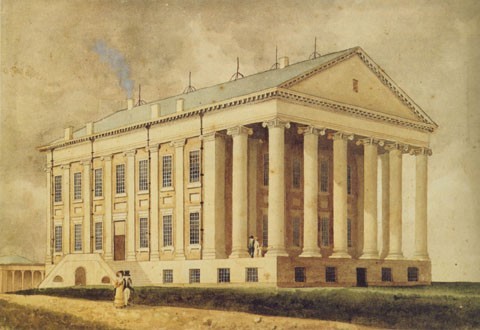
William Goodacre, Virginia Capitol in 1830, Richmond, 1830. Watercolor on paper. (Courtesy, Valentine Museum, Richmond, Virginia.)

Interior of the rotunda of the Virginia State Capitol, Commonwealth of Virginia, Richmond, 1788–1789. The Carrara marble statue of Washington was sculpted by Jean Antoine Houdon in 1788. (State Capitol, Commonwealth of Virginia, Courtesy of the Library of Virginia; Photo, Katherine Wetzel.)
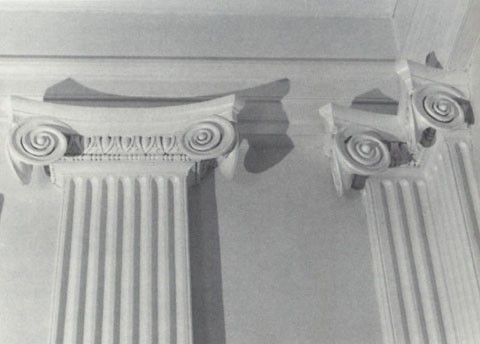
William Hodgson, Ionic capitals in the Senate chamber of the Virginia State Capitol, 1789. Painted wood. (Photo, Katherine Wetzel.)

William Hodgson, truss over the east doorway of the rotunda of the Virginia State Capitol, 1789. Painted wood. (Photo, Katherine Wetzel.)
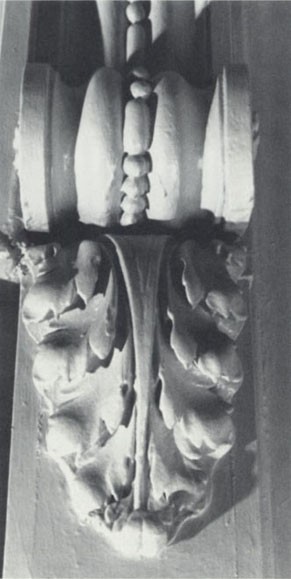
Detail of the acanthus carving on the truss illustrated in fig. 4. (Photo, Katherine Wetzel.)
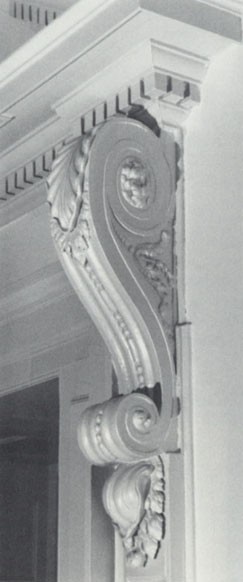
William Hodgson, truss over the north doorway of the rotunda of the Virginia State Capitol, 1789. Painted wood. (Photo, Katherine Wetzel.)

William Hodgson, truss over the north central doorway on the balcony of the rotunda of the Virginia State Capitol, 1789. Painted wood. (Photo, Katherine Wetzel.)
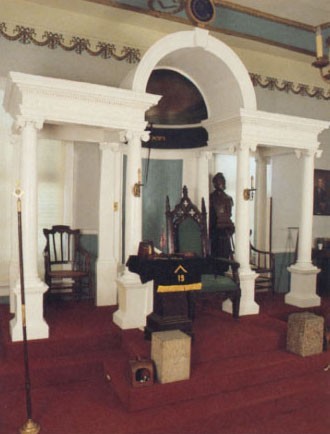
Masonic canopy in Richmond Randolph Lodge 19, attributed to Clotworthy Stephenson and William Hodgson, Richmond, 1788–1791. (Courtesy, Richmond Randolph Lodge 19; photo, Katherine Wetzel.)
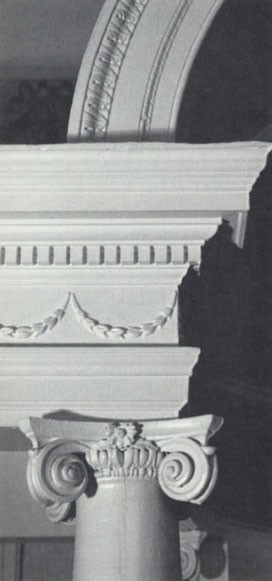
Detail of the Masonic canopy illustrated in fig. 8. (Courtesy, Richmond Randolph Lodge 19; photo, Sumpter T. Priddy III.)

James Crumpley (builder), “Woodlands,” Amelia County, Virginia, 1789–1794. (Courtesy, Helen Scott Townsend Reed; photo, Katherine Wetzel.)
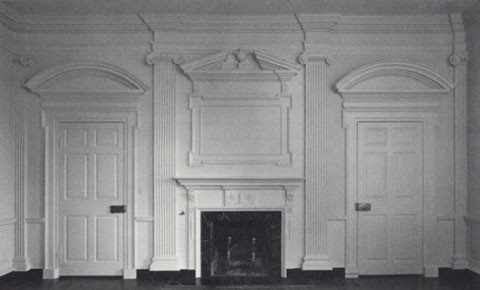
Chimney wall in the principal parlor on the first floor of “Woodlands.” The woodwork is attributed to Clotworthy Stephenson, and the carving is attributed to William Hodgson. (Courtesy, Mills Lane IV; photo, Van Jones Martin.)
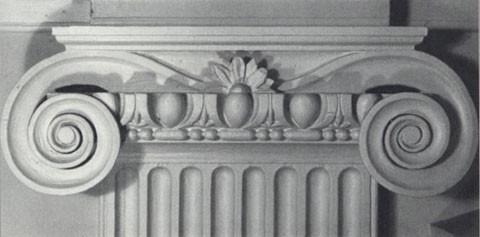
Detail of the left Ionic capital of the chimney wall illustrated in fig. 11. (Photo, Sumpter T. Priddy III.)

Detail of the right truss, rosette, and husk garland on the chimneypiece illustrated in fig. 11. (Photo, Katherine Wetzel.)
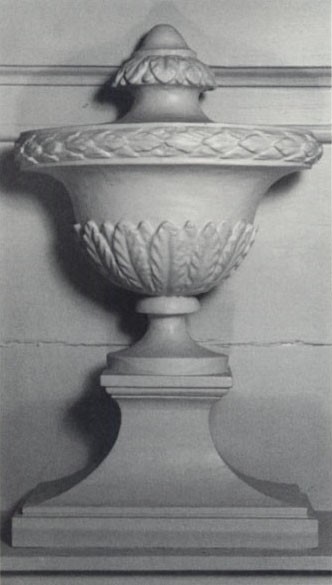
Detail of the urn ornament of the chimneypiece illustrated in fig. 11. (Photo, Sumpter T. Priddy III.)
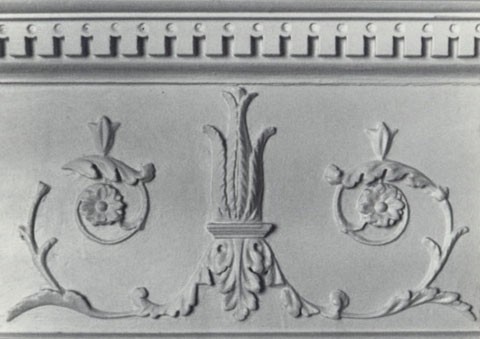
Detail of the tablet appliqué of the chimneypiece illustrated in fig. 11. (Photo, Katherine Wetzel.)

Desk-and-bookcase attributed to Henry Ingle and William Hodgson, Richmond, inscribed “Dabney Minor” and dated “Jan. 24th, 1789.” Mahogany and mahogany veneer with yellow pine, tulip poplar, walnut, birch, and cherry. H. 92 1/2", W. 44 3/8", D. 21 1/2". (Private collection; photo, Gavin Ashworth.)
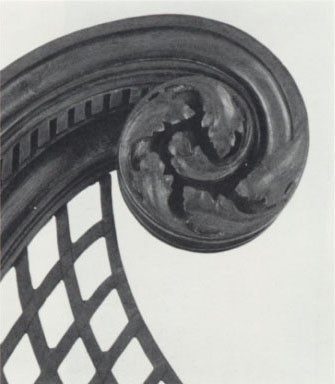
Detail of the rosette of the desk-and-bookcase illustrated in fig. 16. (Photo, Gavin Ashworth.)
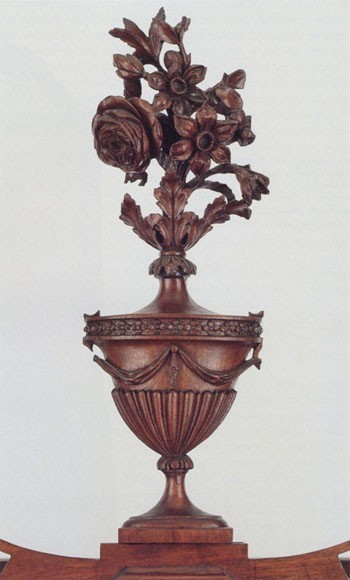
Detail of the urn-and-flower ornament of the desk-and-bookcase illustrated in fig. 16. (Photo, Gavin Ashworth.)
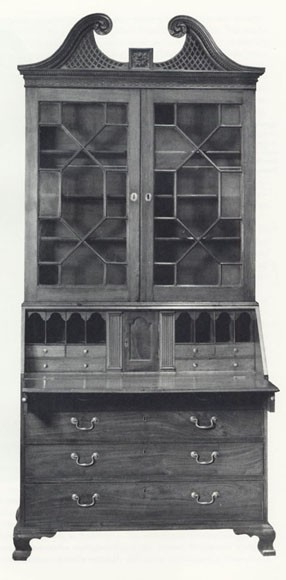
Desk-and-bookcase attributed to Henry Ingle and William Hodgson, Richmond, inscribed “B. Tanner,” ca. 1790. Mahogany and mahogany veneer with yellow pine and tulip poplar. H. 93 1/2", W. 44 1/2", D. 21 3/4". (Private collection; photo, Museum of Early Southern Decorative Arts.)
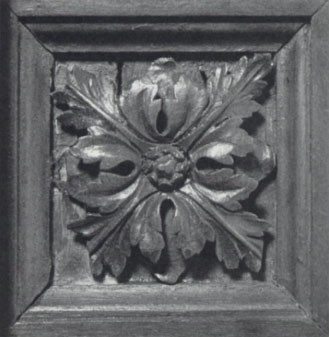
Detail of the carved plinth block on the pediment of the desk-and-bookcase illustrated in fig. 19. (Photo, Sumpter T. Priddy III.)
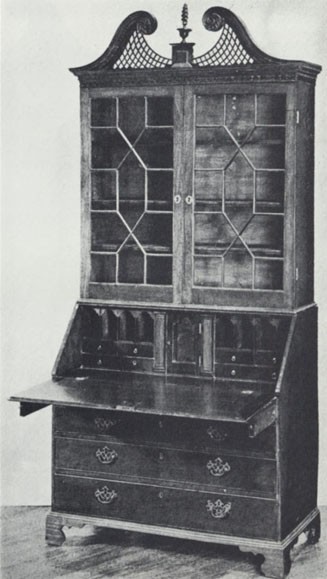
Desk-and-bookcase attributed to Henry Ingle and William Hodgson, Richmond, ca. 1790. (Francis Clary Morse, Furniture of the Olden Time [1902; reprinted and enlarged 1917, New York: MacMillan, 1940], p. 143; photo, Museum of Early Southern Decorative Arts.)

Desk-and-bookcase attributed to Daniel Trotter, Philadelphia, ca. 1780. Mahogany with tulip poplar and white cedar. Dimensions not recorded. (Courtesy, Girard College.)
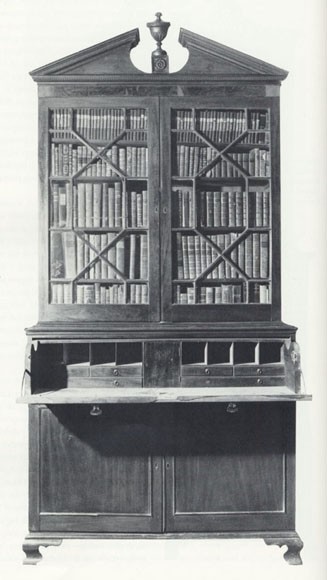
Secretary-and-bookcase attributed to Henry Ingle and William Hodgson, Richmond, ca. 1790. Mahogany and mahogany veneer with white pine, cherry, and tulip poplar. H. 99" (less ornament), W. 49 1/2", D. 23 1/4". (Private collection; photo, Museum of Early Southern Decorative Arts.)
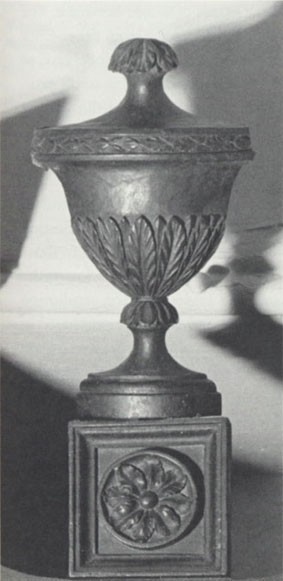
Detail of the plinth block and ornament of the secretary-and-bookcase illustrated in fig. 23. (Photo, Museum of Early Southern Decorative Arts.)
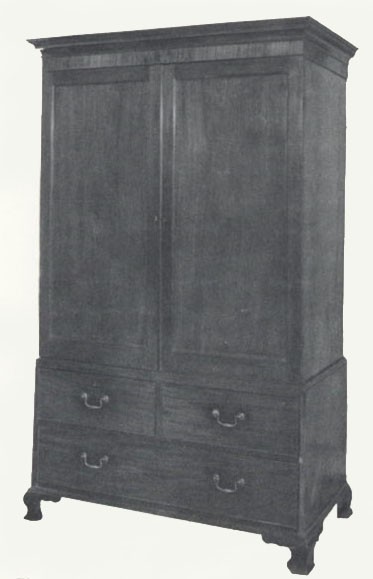
Clothespress attributed to the school of Henry Ingle, Richmond, ca. 1790. Mahogany and mahogany veneer with yellow pine. H. 80 3/4", W. 50", D. 22 5/8". (Private collection; photo, Museum of Early Southern Decorative Art.)
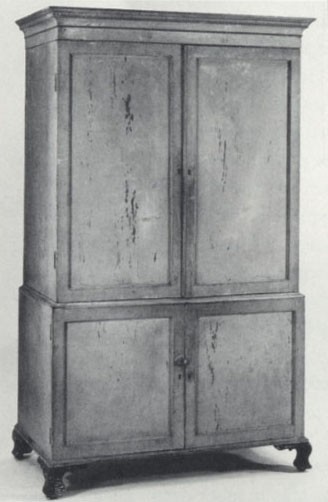
Clothespress attributed to the school of Henry Ingle, Richmond, ca. 1790. Painted yellow pine. H. 83", W. 52 1/4", D. 26 1/4". (Colonial Williamsburg Foundation, acc. 1968–279.)
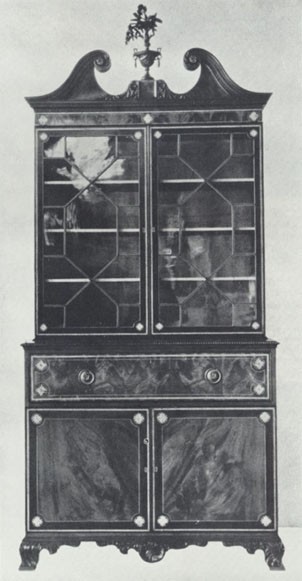
Secretary-and-bookcase attributed to Henry Ingle and William Hodgson, Richmond, ca. 1790. Materials and dimensions not recorded. (Edward Wenham, The Collector’s Guide to Furniture Design [New York: Collector’s Press, 1928], p. 144; photo, Luke Beckerdite.)

Library bookcase, Philadelphia, 1785–1795. Materials and dimensions not recorded. (William Mcpherson Hornor, Blue Book of Philadelphia Furniture [1935; reprinted, Washington, D. C.: Highland House, 1977], p. 251; photo, Luke Beckerdite.)

Secretary-and-bookcase, Richmond, 1790–1800. Mahogany, mahogany veneer, and unidentified light and dark inlays with tulip poplar, oak, and yellow pine. H. 88 5/8", W. 46", D. 22 3/4". (Private collection; photo, Museum of Early Southern Decorative Arts.)
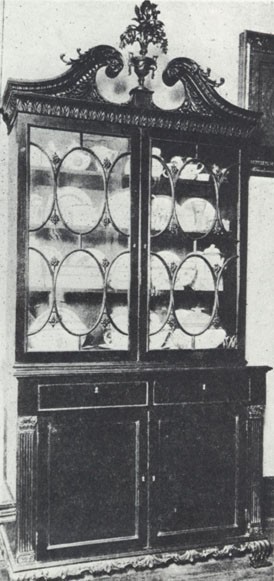
Desk-and-bookcase with an urn-and-flower ornament attributed to William Hodgson, Richmond, ca. 1790. Materials and dimensions not recorded. (Francis Clary Morse, Furniture of the Olden Time [1902; reprinted and enlarged 1917, New York: MacMillan Co., 1946], p. 143; photo, Luke Beckerdite.)

Library bookcase with urn-and-flower ornament attributed to William Hodgson, England (library bookcase) and Richmond (ornament), 1770–1780 (library bookcase) and ca. 1790 (ornament). Mahogany with oak and deal. The library bookcase was altered to fit into a specific space in the principal first-floor room of the John Marshall house, built in Richmond between 1789 and 1791. (Courtesy, Association for the Preservation of Virginia Antiquities; photo, Katherine Wetzel.)
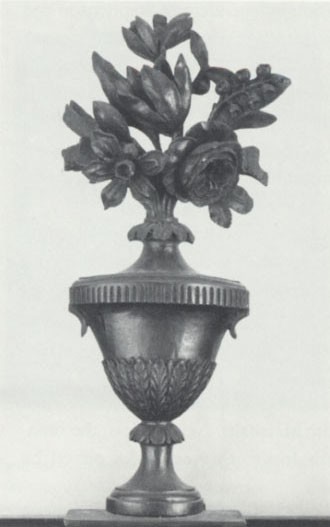
Detail of the ornament of the library bookcase illustrated in fig. 31. (Photo, Katherine Wetzel.)

Detail of the chimney-piece illustrated in fig. 31. The composition ornaments on the chimneypiece and in the metopes are attributed to William Hodgson. (Photo, Katherine Wetzel.)

Detail of one of the composition paterae in the metopes of the room illustrated in figs. 31 and 33. (Photo, Katherine Wetzel.)
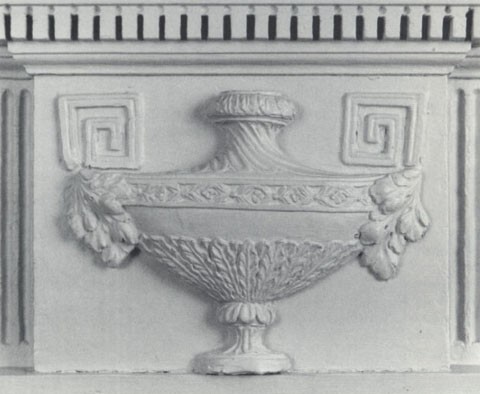
Detail of the composition urn on the tablet of the chimneypiece illustrated in fig. 33. (Photo, Katherine Wetzel.)
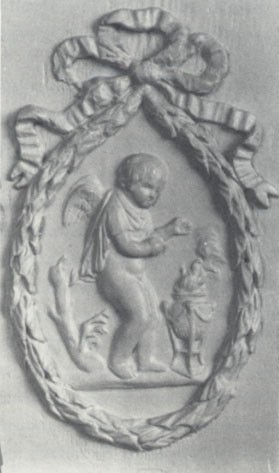
Detail of the composition ornament depicting “Winter” on the chimneypiece illustrated in fig. 33. (Photo, Katherine Wetzel.)
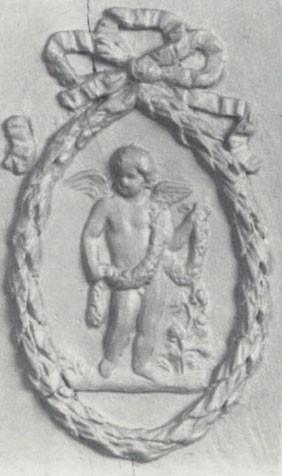
Detail of the composition ornament depicting “Spring” on the chimneypiece illustrated in fig. 33. (Photo, Katherine Wetzel.)
Of all the Arts which are either improved or ornamented by Architecture, that of cabinet-making is not only the most useful and ornamental, but capable of receiving as great Assistance from it as any whatever.
Thomas Chippendale
The Gentleman and Cabinet-Maker’s Director (1754)
The relationship between architecture and furniture in eighteenth-century America and the close associations between artisans who constructed buildings and those who constructed furniture are exemplified in the work of three talented tradesmen who moved to Richmond, Virginia, in the 1780s. The first, Clotworthy Stephenson, was an Irish joiner who arrived in Virginia by 1787 and executed the interior woodwork for the new Virginia Capitol. In 1793 he moved to Washington, D.C., and oversaw much of the construction of the United States Capitol. The second, British-trained carver William Hodgson, immigrated to Virginia by 1784 and resettled in Richmond by 1788. Over the following twenty years, he carved woodwork for the Virginia Capitol and for private dwellings, and he ornamented furniture for cabinetmakers in the Richmond area. The third, Philadelphia-trained cabinetmaker Henry Ingle, moved to Richmond in 1788 and established a shop at the base of Capitol Hill. Periodically working together, these three men produced some of the most significant woodwork and furniture in late eighteenth-century Virginia.[1]
Having moved from Williamsburg to Richmond for a safe haven from British troops in 1780, the Virginia legislature appropriated £30,000 for a capitol building in Richmond and appointed Governor Thomas Jefferson to oversee its design. Jefferson drew preliminary plans for the structure that year, but it was not until 1784 and his appointment to the position of minister to France that the project moved forward. With the assistance of French antiquarian Charles Louis Clérriseau, Jefferson completed the designs and provided specifications through correspondence with the nine Directors of Public Buildings for the Commonwealth of Virginia. Drawings for the design, based upon the Maison Carrée, arrived in Richmond in 1785, followed by a plaster model in 1786. This design called for the first freestanding temple-form building in the new nation, and it met with immediate acclaim (fig. 1). Slated for one of the highest prospects in Richmond, Shockoe Hill, the Capitol would overlook the James River and the agricultural lands of southern Virginia.[2]
The Capitol at Richmond was the largest public commission under construction in America during the 1780s, and the fledgling community of approximately 1,800 inhabitants, half of whom were slaves, was unable to provide enough skilled artisans to accomplish the task. From the beginning, the directors of the project understood that outside tradesmen would be needed to complete the building.[3]
Irish joiner Clotworthy Stephenson probably arrived in America in 1785. He moved to Richmond by August 28, 1787, when he took an Oath of Fidelity to the Commonwealth “in Order to entitle himself to the rights of a Citizen.” The following January, Governor Edmund Randolph drew on the state’s contingent fund to pay Stephenson £3.3.0 “for making a Table to a Copying press for the use of the Executive.”
From 1789 to 1790, Stephenson worked with joiner John Hart, and together they constructed most of the interior woodwork for the new Capitol. Their £604.16.0 worth of “Joyners Work done in the Capitol in the year 1789” included over 1,000' of columns and pilasters, over 900' of entablature, dado, windows, moldings for chimneypieces and niches, balustrades, and the doorways’ “Raking and level Cornices,” the most elaborate of which appear in the Capitol rotunda (fig. 2).[4]
Assisting Stephenson and Hart was William Hodgson, a talented tradesman who had previously resided in Norfolk. In 1789, Hodgson submitted a voucher for carving two large and ten smaller trusses (also known as consoles or brackets) supporting the “Raking and level cornices,” fourteen Ionic capitals for the Council chamber, and six Ionic capitals for the Senate. The carving came to £64.18.0, and with the labor for painting and putting up the capitals, his invoice totaled £75.[5]
The capitals of the Council chamber were destroyed when an overloaded courtroom above the chamber collapsed in 1870, but the capitals in the Senate chamber survive. Two are on the pilasters on the north wall, and the other four cap the paired pilasters in the corners of the room (fig. 3). Stylistically, these capitals differ from the ones that Jefferson designed for the exterior and represent a departure generally attributed to the building’s superintendent, Samuel Dobie. Each capital carved by Hodgson is deeply modeled, with the spiral of each volute separated from the preceding turn as it tightens inward. Egg-and-dart and bead-and-reel moldings span the volutes, and a central patch now occupies the space originally filled by a carved flower. Unlike Ionic capitals from antiquity, which have a single volute on each corner, Hodgson’s have converging volutes that give a finished appearance from the front and side. Such capitals are based on designs by Italian Renaissance architect Vincenzo Scamozzi (1552–1616), a student of Andrea Palladio. Scamozzi capitals are rare in eighteenth-century America, where architects and builders preferred the single volute commonly found in antiquity.[6]
Careful inspection of the surviving trusses reveals four different designs. The first is found on the two principal doorways of the south entry (not illustrated); the second on the east, west, and south doorways of the rotunda (figs. 4, 5); the third on the north doorway of the rotunda (fig. 6); and the fourth on the doorways opening onto the balcony of the rotunda (fig. 7).[7] Despite the stylistic differences in their designs, the physical evidence suggests that William Hodgson carved all twenty-four of the trusses. Each leaf has a concave central channel (or flute) rather than a raised vein or rib, as is commonly found in the work of other carvers. As the channel approaches the tip of each leaf, it flows into a raised, rounded nodule. The tip of each leaf then falls away, as though clipped across the surface with a single gouge cut (see fig. 5). Such details are easily recognizable in the leafage at the base of the trusses on the south, east, and west doorways in the rotunda, on the doorways of the south entry, and below the smaller trusses on the balcony.
Certain details appear less refined than others and initially suggest that Hodgson’s shop included a journeyman or apprentice of considerably less skill. This difference is most apparent on the north doorway of the rotunda and on the sides of the twelve smaller trusses on the balcony, where the acanthus leaves and husks (or bell-flowers) are simpler in design and less finished than those on the sides of the trusses on the east and west doorways. However, other carving attributed to Hodgson indicates that, though he was capable of exceptional artisanry, he sometimes executed lesser work, particularly for areas of secondary importance.
William Hodgson also carved at least one piece of architectural furniture that Clotworthy Stephenson made for the Capitol. In November 1789, Hodgson billed the directors for “blocking & Carving Elbows for the Judge’s Seat.” Records of Stephenson’s work strongly suggest that this seat was built-in like those in other eighteenth-century Virginia courtrooms. His invoice listed “Steps of Stairs to Judges Seat,” along with 111'4" of “circular seats,” 422'8" of “straight seats,” and 120 “bracketts” that supported the straight seats in the court. All were destroyed in 1870.[8]
In addition to architectural joinery and built-in seating, Stephenson also made the finest of the conventional furniture for the building. He received £6.12.10 for a painted “Bookcase . . . with Double folding doors, Brackett feet Sliding Shelves Pedament Top &c.” for the auditors office, and £6.0.0 for a similar “Book press” with “pidgeon holes” and £5.14.6 for a “Double Writing Desk Eight feet Long with Six Drawers and Slides at one End” for the High Court of Chancery.[9]
None of Stephenson’s furniture survives, but one other example of his architectural joinery remains in Richmond—an elaborate Palladian canopy made to cover the Masonic Master’s chair of Richmond Randolph Lodge 19, where he served as Senior Warden (fig. 8). The entablature moldings used on this remarkable structure are close enough in proportion and detail to those of the balcony doorways at the Capitol to suggest that Stephenson’s shop executed all of them at approximately the same time (compare figs. 7 and 9).[10]
The carved details on the Masonic canopy are attributed to William Hodgson. The Ionic capitals vary only slightly from the documented examples in the Senate chamber (compare figs. 3 and 9), and the husks on the frieze are closely related to those on the sides of the balcony trusses in the Capitol (compare figs. 7 and 9). Only the backband of the arch, which has relief-carved acanthus leaves, is absent from the vocabulary of ornament recorded at the Capitol.
Although written documentation is lacking, evidence suggests that Stephenson and Hodgson collaborated on at least one private architectural project—Woodlands. Built in Amelia County by planter Stephen Cocke (1751–1794), Woodlands is remarkable for its pedimented facade and four-square plan. Temple-form houses with symmetrical wings were a popular Palladian convention, but such pedimented structures without wings were virtually unknown in America before the construction of the Virginia Capitol. Woodlands marks a point of departure from traditional domestic architecture in Virginia (fig. 10). Together with the John Marshall house, simultaneously under construction in Richmond just two blocks north of the new Capitol, Woodlands represents an important transition in acceptance of the neoclassical style in Virginia.[11] It is not known whether the Capitol inspired the design of these houses or whether Stephenson or another Capitol artisan introduced the temple form into the realm of domestic architecture.
The principal “undertaker” for Woodlands was Petersburg joiner James Crumpley, and the provincial character of most of the architectural details suggests that he directed the joiners who fabricated them.[12] The exception is the principal room on the first floor (fig. 11), which contains some of the finest interior woodwork made in Virginia during the last quarter of the eighteenth century. The pediment and raking cornice of the overmantle bear a striking resemblance to those of the Capitol rotunda (compare figs. 2 and 11) and probably represent the collaborative efforts of John Hart and Clotworthy Stephenson.
The carving in the principal room is attributed to Hodgson. The Ionic capitals have volutes carved in a manner similar to those in the Senate chamber (compare figs. 3 and 12), and the acanthus-draped trusses on the mantle (fig. 13) are simplified versions of those on the Capitol doorways (compare figs. 4–7 and 13). Two details in Woodlands provide benchmarks for identifying other carving by Hodgson. The urn finial of the chimneypiece (fig. 14) is related to the pediment ornaments of several late-eighteenth-century Richmond case pieces (see figs. 23 and 24 later in this article), and the acanthus reinceau, husks, and rosettes of the tablet appliqué (fig. 15) have direct parallels in local furniture carving and composition ornaments.[13]
Richmond-made furniture with carving attributed to Hodgson includes three desks-and-bookcases (figs. 16, 19, 21) with intricate latticework pediments and scroll volutes with “hollowed” acanthus leaves that are virtually identical to those on the Capitol trusses (compare figs. 5 and 17). One desk-and-bookcase also has an elaborate vase ornament with naturalistic flowers (figs. 16, 18) that are similar to those on the sides of the trusses over the south, east, and west doorways of the Capitol rotunda (figs. 4, 5, 7). With its naturalistically modeled flowers and leaves, this ornament provides a significant gauge of Hodgson’s most accomplished work.[14]
The desk-and-bookcase illustrated in figure 16 has two chalk inscriptions—“Jan 24th 1789” and “Dabney Minor.” Dabney Minor (1749–1799) lived at Woodlawn, Orange County, Virginia, and was a prosperous carpenter appointed by the Directors of Public Buildings to work on the Capitol. Living in Richmond when construction began, he did not return to Orange County until 1796, just as finishing touches were being put on the building.[15]
Dabney Minor built several pieces of furniture for the Commonwealth of Virginia; however, documentary evidence discounts him as the maker of this desk-and-bookcase. In an indenture dated January 26, 1789, Minor described himself as a “carpenter” rather than as a cabinetmaker. Second, receipts pertaining to the construction of the Capitol reveal that he provided a wide range of modest services including carpentry and simple furniture joinery. In 1790 he billed the Directors of Public Building for a “Box to Send Books to Philadelphia,” for a “pr Hinges for the Garden Gate,” for “Repairing Roof of House,” for “94 pannels [of] planking,” and for three large tables for the General Court and “Committy” rooms. Two of the tables were painted, but the surface of the third—the cheapest one—was unspecified. His furnishings for the governor included “2 large pine tables” and “3 pine bedsteads for the Gov[ernor’s]. Negroes.” He also charged £1.16.0 for “1 large Oval Table for the Sennett,” £3.15.0 for “3 large Tables painted w. 1. draw. for ye use of ye Assembly,” and £32.8.0 for eight “large” bookcases for the offices “under . . . [the] portico” of the Capitol. Presumably these pieces were pine and unpainted, because no materials are specified.[16]
Another desk-and-bookcase is similar to the Minor example both in style and construction (fig. 19). Although lacking its ornament, this piece has its original acanthus-carved plinth block and arched prospect door (figs. 19, 20). Fitted with glazed doors sporting “Chinese” mullions, this item was undoubtedly the more expensive of the two. It has a chalk inscription “B. Tanner” written by the same hand as that on the Minor example. Branch Tanner (d. 1794) was a wealthy planter who owned land near Woodlands in Amelia County and had another sizable tract just south of Richmond in Chesterfield County.[17]
These two desks-and-bookcases, together with a third whose history and current location are unknown (fig. 21), are among the most aspiring designs for case furniture produced in eighteenth-century Virginia. Stylistically, however, they are more closely indebted to Philadelphia prototypes than to currently recognized Virginia examples. Their ogee feet, graduated drawers, and desk interiors are relatively generic, but their latticework tympana, scroll pediments, and spiral, acanthus-carved volutes clearly derive from Philadelphia examples of the 1760–1780 period.
Similarly, several structural features seem strongly indebted to traditional Philadelphia cabinetmaking practices. The construction of the dustboards—which are thinner than the drawer blades and are wedged into dadoes ploughed in the case sides—is one of the most common construction methods on eighteenth-century Philadelphia case pieces. The attachment of the waist molding to the upper case and the practice of screwing the two sections together also is consistent with contemporary Philadelphia work. Despite these parallels, several structural features appear to be concessions to Virginia cabinetmaking traditions: the side-to-side orientation of the drawer bottoms (Philadelphia drawers often have bottom boards that run front to back), the use of birch as a secondary wood, and the employment of stack-laminated (or “composite”) support blocks for the feet. This last detail is extremely rare in Philadelphia and is more commonly representative of furniture made in Williamsburg and eastern Virginia during the colonial period. Although these pieces could represent the work of a Virginia artisan inspired by an imported Philadelphia desk-and-bookcase, it is far more likely that they represent the work of a Philadelphia-trained cabinetmaker who employed regional workmen in his shop. This latter possibility is strongly suggested by the documentary evidence; of the cabinetmakers in Richmond during this period only Henry Ingle (1764–1822) had trained in Philadelphia.[18]
Henry Ingle was a talented, socially connected journeyman when he arrived in Richmond in 1788. Born in Germantown, just outside Philadelphia, Ingle was apprenticed at the age of nine to John Webb, variously referred to as a cabinetmaker and a house joiner. Ingle’s apprenticeship papers committed him to serve for twelve years and eight months—an usually long term evidently owing to his age.[19]
Webb operated one of the largest and most successful cabinet shops in Philadelphia. No documented pieces are known, but the taxes assessed for his annual production in 1783 and 1786 were £60 and £75 respectively. Although less than the largest Philadelphia shops, his assessments were well ahead of those of such Philadelphia notables as William Savery and Thomas Tuft, whose annual production incurred £50 tax. Webb enjoyed a long career and is listed as a cabinetmaker and joiner in Philadelphia directories as late as 1800.[20]
Insights into the skills that Webb taught Ingle are suggested by the work of another Philadelphia cabinetmaker, Daniel Trotter (1747–1800), who was in partnership with Webb from 1771 to 1773. Documented pieces by Trotter are dated after that partnership; however, a desk-and-bookcase (fig. 22) that Trotter made for Philadelphia merchant Stephen Girard provides evidence of the level of artisanry in which Ingle was schooled.[21]
Henry Ingle was legally bound to remain in Webb’s shop until 1785, but he packed up his tools and personal possessions in 1784 and headed south, most probably with his master’s blessings. The young journeyman moved to Albemarle County, Virginia, the birthplace of Thomas Jefferson and, from the late 1760s onward, the site of his home, Monticello. Documentary evidence does not irrefutably link Ingle and Jefferson until 1791, when both men were living in Philadelphia. Yet, circumstances strongly suggest that they met earlier—perhaps during the Second Continental Congress (1783–1784)—for it is otherwise difficult to explain how a Pennsylvania tradesman who shared a lifelong allegiance to Jefferson would appear in rural Albemarble County and subsequently at the Capitol in Richmond at the precise moment that Jefferson left America to serve as minister to France.[22]
One hypothesis for Ingle’s move to Virginia is suggested by a secretary-and-bookcase attributed to him and William Hodgson (fig. 23). According to oral tradition, this piece originally belonged to Colonel Nicholas Cabell (1750–1803) of “Liberty Hall” in Amherst County, which adjoins Albemarle. Colonel Cabell was a college classmate and friend of Jefferson, and the two frequently spoke and corresponded about architecture and the decorative arts. The Cabells were among the wealthiest and best-educated families in Virginia, and their success in agriculture and business enabled them to engage in extensive house building during the late eighteenth century. Jefferson may have recommended Ingle to his friend shortly before leaving for France; however, Cabell probably commissioned this particular piece five to ten years later.[23]
The design of the secretary-and-bookcase, having a writing compartment concealed in a drawer with a compass-hinged front, represents an important stylistic shift from the traditional slant-front desk. The raking cornice is the only such example from Ingle’s Richmond period, and, though it bears an affinity to Clotworthy Stephenson’s work at the Capitol, the cornice differs substantially in detail (compare figs. 2 and 23). In a further departure from the preceding desks-and-bookcases, Ingle employed cross-banding rather than a pierced guilloche for the bookcase frieze. Despite these differences, this piece shares a number of details with the preceding examples, including interior drawer construction and moldings profiles.
The carved vase ornament of the Cabell secretary-and-bookcase is very similar to the one at Woodlands (figs. 14, 24), and it sits on a rectangular plinth like the vase-and-flower ornament of the Tanner desk-and-bookcase (fig. 20). In the center of the plinth is a carved mahogany rosette that is similar to other rosettes attributed to Hodgson (figs. 7, 15, 34). As on the Minor and Tanner desks-and-bookcases, the plinth and vase of Colonel Cabell’s piece are not carefully integrated into the design of the tympanum (figs. 16, 19, 23); rather, they appear to be placed on top of the cornice molding as an entity unto themselves, much like those that Hodgson carved for Clotworthy Stephenson’s chimneypiece in Woodlands (fig. 11). This feature commonly appears in British design books and occasionally on furniture and architecture from eastern Virginia. Ingle’s departure from conventional Philadelphia design, where the tympanum usually sweeps up and encompasses the base of the plinth, represents an important concession to regional preferences.
A mahogany clothespress and a painted yellow pine clothespress are the only examples of utilitarian furniture associated with Ingle (figs. 25, 26). Both have histories of descent in the Tabb family of Matthews County, Virginia. Although clearly related to the preceding desks-and-bookcases and secretary-and-bookcase, the presses differ in subtle detail. Their feet and cornices are slightly larger in scale and have profiles slightly different from others in the group. There are no dustboards in the mahogany press, but the drawer construction is virtually identical to that of figures 16, 19, and 23. Construction differences notwithstanding, the presses have enough of an affinity with Ingle’s other work that they can certainly be attributed to his sphere, if not to his shop.[24]
A secretary-and-bookcase made in Richmond and now known only from an early photograph is the most elaborate piece attributed to Ingle and Hodgson (fig. 27). Although aspects of the case design differ significantly from other work attributed to Ingle’s shop, the cornice moldings and frieze are similar to those of the Cabell and Tabb pieces and the vase-and-flower ornament is virtually identical to that on the Minor desk-and-bookcase. The veneers and inlays of figure 27 also represent a departure from other work attributed to Ingle; however, these details are no less indebted to Philadelphia prototypes than his basketweave tympana or his scroll pediments. The unusual geometric medallions on the doors and the writing drawer are virtually identical in detail and placement to those on an elaborate library bookcase (fig. 28) made in Philadelphia about 1790 for Revolutionary War hero James Hunter (1729–1796). Initially, one might question the authenticity of the boldly carved ogee feet, the central pendant of the skirt, and the gadrooned waist molding, but under magnification they appear to be original and the feet bear a striking resemblance to those of contemporary Irish pieces. It is thus conceivable that Clotworthy Stephenson played some role in its design. An Ingle-Hodgson attribution for figure 27 is reinforced by another secretary-and-bookcase purchased in Richmond in 1904 (fig. 29). Although the latter example is later in date and technically less accomplished, it probably represents the work of an artisan on the periphery of the Ingle-Hodgson school.[25]
The quantity of furniture attributed to Henry Ingle’s Richmond period is remarkable considering his brief career in the state. On October 27, 1789, he announced his intention of leaving the Commonwealth and requested those indebted to him to settle their obligations. In a separate advertisement published the same day, he reported that he would sell:
at . . . auction . . . a large assortment of elegant new Mahogany furniture, consisting of CHAIRS, DESKS AND BOOKCASES, DINING AND CARD TABLES, SIDEBOARDS AND BREAKFAST DITTO, HIGH AND LOW POST BEDSTEADS, FIELD AND CANOPY DITTO, CRADLES AND CANDLESTANES, &C.
Henry Ingle’s precise date of departure and destination are unknown. He returned to Philadelphia by 1791 and subsequently moved to Washington.[26]
Hodgson continued to ply his trade in Richmond. A bookcase illustrated in Frances Clary Morse’s Furniture of the Olden Time has one of Hodgson’s most elaborate ornaments (fig. 30). Although the character of the carved feet bear a vague resemblance to the secretary-and-bookcase illustrated in figure 27, disparate stylistic and structural details—Ionic pilasters, paneled ends of the lower case, unconventional mullion design, and florid carved pediment—suggest that the bookcase was altered during the late nineteenth century. Nonetheless, the exquisite ornament capping the piece differs only slightly from that of the Minor desk-and-bookcase, and it appears to be the most complete of Hodgson’s surviving ornaments.[27]
Hodgson’s most important commission independent of Stephenson and Ingle was for furniture carving and architectural details for the principal first-floor parlor and dining room of John Marshall’s house (built 1788–1790), just two blocks north of Capitol Square. Several artisans worked on Marshall’s house, but Hodgson’s name does not appear in any of the documents. Hodgson probably worked, in a modern sense, as a subcontractor. Because he received payment directly from the contractor or “undertaker,” his name never appeared in the owner’s accounts.[28]
Hodgson’s furniture carving in the John Marshall house is represented by an ornament made for an English library bookcase owned by Marshall’s wife, Mary Willis “Polly” Ambler, the daughter of Jaquelin and Rebecca Burwell Ambler (figs. 31, 32). Originally from Jamestown, the Amblers came to Richmond soon after the relocation of the capital, and they constructed a “mansion” between Marshall and Clay streets.[29] It is impossible to determine whether Hodgson carved the ornament when the piece was owned by the Amblers or, subsequently, by the Marshalls. Nonetheless, the ornament clearly is a composite of details from other examples carved by Hodgson (fig. 32).
The Marshall house also provides the only surviving evidence of William Hodgson’s pattern carving for composition ornament (fig. 33). A variety of these cast ornaments are in the principal parlor on the first floor and in a small dining room adjoining it. The parlor has a classical entablature with composition paterae in the metopes (fig. 34). Alternately round and oval, these paterae are virtually identical to the carved mahogany paterae on the plinth block of the Cabell family secretary-and-bookcase (fig. 24). The finest composition ornaments are on the mantlepieces in the two rooms. Hodgson’s most individualistic vase (or urn) carving is represented by the composition examples on the central tablets of the mantles in the parlor (fig. 35) and dining room. Unlike his furniture ornaments, the tablets’ vases are horizontally oriented and have spiral fluted necks and rectilinear handles with broad acanthus overlays.
The seasonal representations applied to the pilasters on the parlor mantle are the only figural ornaments attributed to Hodgson. Winter is represented by a winged cherub warming beside a tripod burner (fig. 36), whereas Spring is represented by a cherub draped in a floral garland (fig. 37). Each is contained within an oval wreath of acanthus leaves bound at the top by a triple bow with trailing ribbons. Hodgson’s estate inventory provides additional evidence for attributing these ornaments to his hand: “1 Nest of drawsers with a quantity of composition” valued at $5 and “60 composition molds” valued at $2.[30]
The composition ornament in the John Marshall house clearly illustrates the work of a English-trained artisan adapting his skills to changing demands. As the rococo style gave way to neoclassicism, so tastes moved away from asymmetrical ornament and gravitated toward geometric repetition. To flourish, tradesmen such as Hodgson had to adopt a new stylistic vocabulary and expand their business to include the production of molds for composition ornament.
Aside from the architectural carving and the composition ornament that Hodgson executed between 1788 and 1794, his later work remains unrecognized. Of the sixty composition molds recorded in his inventory, only those that were used for the Marshall house can be identified. If Hodgson’s style changed, it is not readily discernable among the small body of composition ornament and carving that survives in local buildings. He apparently never advertised. Moreover, none of the few building accounts that survive for Richmond structures from the last decade of the century provides evidence of his later work. Further identification is complicated by the massive destruction of Richmond’s early buildings, which were lost through the vicissitudes of war, through neglect, and in more recent years, through demolition.
Although Hodgson’s skills allowed him to flourish during the 1780s and early 1790s, he undoubtedly had difficulty competing with inexpensive, composition ornaments imported from abroad and from the north. His greatest domestic competition probably came from British immigrant George Andrews. Thomas Jefferson strongly encouraged Andrews to establish a composition manufactory in Washington, where the latter could provide decorations for the many public and private buildings under construction in the District of Columbia during the early nineteenth century. Andrews made ornaments for the White House in 1800 and for Monticello in 1804.[31]
Hodgson’s local market was severely undercut by Andrews. James Oldham, a Philadelphia-trained joiner who moved to Richmond in 1804, informed Jefferson of the difficulty he was having finding suitable ornaments for a Richmond project: “The agreement with Mr. Hudson [Hodgson] and my self was that he should furnish his composition at the same price that it would cost at Washington.” Yet, after comparing prices, Oldham reported that he had “declined having any that are made in this place,” and that he would instead purchase the ornaments from George Andrews. Oldham continued, “I am persuaded his ornaments will meet with a ready sale in Richmond and hope he will send an assortment immediately.” By 1805, Hodgson’s local market was being displaced by products from over a hundred miles away.[32]
Hodgson died in the summer of 1806, and his body was interred in the burial ground at St. John’s Church, Richmond, across Shockhoe Valley from the Capitol where he started his Richmond career. His son Joseph T. Hodgson was the administrator of his estate. There were no woodworking or carving tools enumerated, he owned no real estate, and the total value of his possessions was a modest $131. Submitting his estate accounts were Windsor-chairmaker Samuel Pointer, merchant Benjamin Wolfe, and William McKim, a builder and friend who also worked on the Capitol and the Marshall house.[33]
Henry Ingle’s later career proved to be more successful than Hodgson’s. After moving to Philadelphia by 1791, he joined his brother Joseph in the cabinetmaking business. Henry and Joseph Ingles’ shop was located at 273 High Street, next door to the residence of Thomas Jefferson, who lived in Philadelphia while serving as secretary of state. In 1791, Henry married Mary Pechin, daughter of wealthy Philadelphia merchant Christopher Pechin and his wife Christina. During the next eight years, the Ingles resided in a small house owned by Pechin on Elfreth Alley. Joseph moved to Alexandria, Virginia, by 1793 and subsequently purchased a shop at 112 South Royal Street. Six years and several children later, Henry again joined his brother. From Royal Street, they conducted the funerals of George and Martha Washington.[34]
In 1800, Henry moved to New Jersey Avenue, near the construction site of the United States Capitol. From there, he concentrated on the building trades and reportedly constructed the first speculative housing in the District of Columbia, known during the period as “Ingle Row” (on the current site of the Offices of the House of Representatives). He established the District’s first hardware store and shipped goods up the Potomac to western Maryland and Virginia and across the piedmont to Thomas Jefferson at Monticello. In 1806 Ingle served on the first Common Council for Washington, D.C., and, as a vestryman for Christ Church, Navy Yard, in 1807, he supervised the development of the burial ground designated as the Congressional Cemetery. Ingle eventually retired to his elaborate house, “Ingleside,” in the Mt. Pleasant section of Washington. He died in 1822, one the wealthiest and most revered men in the city.[35]
Clotworthy Stephenson’s later career is no less illustrious. Leaving Richmond in 1792, he moved briefly to Annapolis where he served as Junior Warden of the newly established Grand Lodge. The Master of the Lodge was architect Joseph Clarke, who supervised the construction of several public buildings including the new Maryland State House. It is likely that Stephenson worked with Clarke on some of these projects. By 1793, Stephenson moved to Washington where, accompanied by Clarke and architect James Hoban, he served as Grand Marshall in the ceremony to lay the cornerstone of the United States Capitol.
It is not known whether Stephenson and Hoban knew each other in Britain, but the parallels in their careers are close enough to suggest that they did. Both probably arrived in America in 1785. In the summer of 1787, when Stephenson moved to Richmond to work on the new Capitol, Hoban moved to South Carolina and probably designed the new state house and supervised its construction. Both men had workshops that produced architectural joinery and furniture, and both moved to Washington within a year of each other. Hoban hired Stephenson to oversee the workmen building the United States Capitol, and together they laid the cornerstone in an elaborate Masonic ceremony.[36]
After leaving the employ of Hoban, Stephenson had a successful career on his own. In 1798 he helped the Fairfax County, Virginia, Commissioners select plans for public buildings and built the Alexandria Theater. In Washington, he collaborated with Benjamin Henry Latrobe on the design and construction of the Navy Yard and worked with Hoban on the Washington Market and Blodgett’s Hotel. He died in Washington in 1819 and was buried in a Masonic ceremony.[37]
Clotworthy Stephenson, William Hodgson, and Henry Ingle dominated a brief but significant moment in the history of the arts in Virginia. Their legacy is one of the most cohesive yet diverse groups of material objects to survive from the late eighteenth century.
Clotworthy Stephenson’s accomplished architectural joinery; Henry Ingle’s sophisticated casework; and William Hodgson’s carving for architecture, furniture, and composition ornament attests to the versatility of eighteenth-century artisans and their adaptability in an agricultural society where the demand for specialized work clearly was limited.
ACKNOWLEDGMENTS
For assistance with this article, the authors thank Luke Beckerdite, William Beiswanger, Chris Colby, Morgan Delaney, Viola Fleming, Peter Grover, Melissa Haines, Ronald Hurst, Jean Kling, Elizabeth Kostelny, Mills Lane IV, Calder Loth, Christine Meadows, Michael Miller, James and Marilyn Melchor, Stephen Patrick, Jonathan Prown, Helen Scott Townsend Reed, Charles Sale, Susan Shames, Edith Sprouse, Cinder Stanton, Susan Stein, Ibby Taylor and family, and Katherine Wetzel. We are especially grateful to Frank Horton, Martha Rowe, and the staff of the Museum of Early Southern Decorative Arts for assistance with our research and photography.
Clotworthy Stephenson Oath of Fidelity, August 8, 1787, Richmond Hustings Court Order Book 2, 1787–1792, p. 190. William Hodgson probably immigrated through Norfolk, Virginia, where he witnessed the will of Francis Hodgson in 1784 (Norfolk Will Book 2, no. 138, January 15, 1784, pp. 392–93). Francis Hodgson was a ship captain who sailed from the James River to Jamaica (Virginia Gazette, September 15, 1774). William Hodgson’s son, Joseph, took an Oath of Allegiance in Norfolk in 1787 (Elizabeth and W. Bruce Wingo, Naturalizations and Declarations of Intention, Norfolk [Norfolk: Wingo Publishing, 1987], p. 17). The earliest reference to Hodgson in Richmond is in the City Personal Property Tax Lists, 1788, p. 7. The earliest reference to Ingle in Richmond is his advertisement in the August 20, 1788, Virginia Independent Chronicle.
For more on the design and construction of the Capitol, see Fiske Kimball, The Capitol of Virginia: A Landmark of American Architecture, ed. Jon Kukla, Martha C. Vick, and Sarah Shields Driggs (Richmond: Virginia State Library and Archives, 1989).
Population statistics for the city of Richmond are in Heads of Families, First Census of the United States Taken in the Year 1790. Records of the State Enumerations of Virginia from 1782 to 1785 (1908; reprint, Bountiful, Utah: Accelarated Indexing Systems, 1978), pp. 111–19.
Stephenson Oath, Richmond Hustings Court Order Book 2, August 28, 1787, p. 190. Although Stephenson is not documented in Richmond until 1787, it is possible that he arrived in America about 1785. By 1790, federal law required a one-year residency in the state and a two-year residency in America prior to taking the Oath of Fidelity. If the law codified an earlier tradition, which is likely, Stephenson probably resided in Virginia before 1787 (Wingo, Naturalizations, p. 1). Edmund Randolph to Clotworthy Stephenson, January 1788, Contingent Fund, Auditor of Public Accounts, no. 2, 1787–1792, p. 190, Virginia State Library and Archives, Richmond (hereinafter cited as APA and VSLA). “The Directors of Public Buildings Dt. in Accot. with Hart and Stephenson for Joyners Work done in the Capitol in the Year 1789,” “Measured and Accompted by S. Dobie,” February 16, 1790, Vouchers, APA, 1788–1789, Capitol Square Data, Records, 1784–1931.
“Mr. Wm. Hodgsons proposals for the Caps of Columns &. Pilasters [illegible] Council Rooms &. of Work done already. Mar: 30. 1789,” Vouchers, APA, 1788–1789.
1788 The Directors of the Public Buildings to Wm. Hodgson
| To 2 Large Trusses @ £ 2.14 10 Smaller Do. @ 1.6 14 Caps for Counl. Cham. @ 2 6 Do. for Sen. Room @ 2.5 To getting out 6 Caps @ 12. . . . To Do 14 Do @ 16 Painting and putting up 6 Caps a/3 Do 14 @ /2 Inspected S. Dobie |
£ 5.8.0 18.0.0 28.0.0 13.10.0 64.18.0 3.12.0 4.4.0 0.0.18 1.1.8 75.0.0 |
For an illustration of the Scamozzi design used on the exterior of the Capitol, see Kimball, Capitol, p. 94.
The number of trusses listed on Hodgson’s voucher do not match the actual number of those in the rotunda and entry. The additional twelve trusses may have been listed on a now-lost voucher, or they may have been invoiced as unspecified work by another Capitol artisan if Hodgson was working as a subcontractor.
The Directors of Public Buildings to W. Hodgson, November 24, 1789, Vouchers, APA, 1788–1790. “Directors of Public Buildings Dr. in Accot. with Hart and Stephenson,” February 16, 1790, Vouchers, APA, 1788–1789. For more on built-in furniture in Virginia courtrooms, see Carl Lounsbury, “The Structure of Justice, The Courthouses of Colonial Virginia,” Thomas Carter and Bernard Herman, eds., in Perspectives in Vernacular Architecture (Columbia, Mo.: University of Missouri Press, 1989), pp. 214–26.
Stephenson served as Senior Warden of the Richmond Randolph Lodge 19 in 1787 (Charles P. Rady, History of Richmond Randolph Lodge No. 19 [Richmond: Fergusson and Son, 1888], p. 2). The authors thank Mr. Charles Sale and the members of Richmond Randolph Lodge 19 for assisting with this research.
Temple-form houses with symmetrical wings are illustrated in several British design books, most notably in Robert Morris’s Select Architecture (London, 1757). Among the best-known American examples are the Redwood Library in Newport, Rhode Island (1748–1750) and the Semple house in Williamsburg, Virginia (ca. 1782).
Records concerning the building of Woodlands are in the Cocke Family Papers at the Virginia Historical Society, Richmond. Accounts between merchants William and James Douglas of Petersburg, Virginia, and builder James Crumpley suggest that Crumpley was the undertaker at Woodlands. These accounts refer to Crumpley’s purchase of materials for the hearth, front steps, shelving, closet fittings, and other building supplies (William Douglas to James Crumpley, n.d., Cocke Family Papers, Virginia Historical Society, Richmond).
Although elements of the chimneypiece in Woodlands are similar to details illustrated in Owen Biddle’s Young Carpenter’s Assistant (Philadelphia: Benjamin Johnson, 1805), the woodwork pre-dates this publication. For more on Woodlands, see Mary Jefferson, Old Homes and Buildings of Amelia County, Virginia (Amelia, Va.: privately published, 1964), p. 40; and Helen Scott Townsend Reed, “Chastain,” The Goochland County Historical Society Magazine 9, no. 1 (Spring 1977): 6–14. Hodgson probably executed the carving for Woodlands in his shop in Richmond. During the eighteenth century, carvers often shipped architectural work great distances. For more on this practice, see Luke Beckerdite, “Philadelphia Carving Shops Part III: Hercules Courtenay and His School,” Antiques 128, no. 3 (September 1985): 1044.
The Museum of Early Southern Decorative Arts (hereinafter MESDA) first recorded the desks-and-bookcases. Two of them and a related clothespress at Colonial Williamsburg are discussed in Wallace B. Gusler, Furniture of Williamsburg and Eastern Virginia (Richmond: Virginia Museum, 1978), pp 132–37. Two bookcases, long separated from their desk sections and pediments, have frieze designs identical to figures 16, 19, and 21. One was owned originally by Richmond merchant John Wickham.
State of Virginia to Dabney Minor, April 1791, Contingent Vouchers, APA. See also Aline H. Zeno, “The Furniture Craftsmen of Richmond, Virginia, 1780–1820,” M.A. thesis, University of Delaware, 1987, p.177.
Indenture between Thomas Clark and Dabney Minor, January 26, 1789, Richmond Hustings Court Book 2, 1787–1792, p. 396. State of Virginia to Dabney Minor, 1790, Contingent Vouchers, APA, no. 139, 1789–1791. The furniture that Minor made for the governor is recorded in State of Virginia to Dabney Minor, December 6, 1792, Records of the Governor’s Mansion, 1791–1826, folder 1791–1821, VSLA. The furniture for the Capitol is recorded in State of Virginia to Dabney Minor, April 24, 1791, Contingent Vouchers, APA, 1789–1791.
Will of Branch Tanner, January 9, 1794, Amelia County Will Book 5, p. 122. Amelia County Deed Book 16, 1781, p. 25. The complete provenance of the Tanner piece is published in Gusler, Furniture of Williamsburg, p. 137, n. 6.
The Dabney Minor desk-and-bookcase has structural features that are representative of this group. It has a removable cornice with a series of shaped glue blocks held to the top of the bookcase by screws. The waist molding is attached to the bookcase, and the bookcase is attached to the desk with two screws. The backboards are horizontal, and they are butted and glued together. The dustboards are tongue-and-grooved to the drawer blades and dadoed to the case sides. The large case drawers have yellow pine frames and bottoms. The bottom boards have beveled edges that are set into grooves in the fronts and sides. They are held in place along the sides with three rectangular glue blocks, the front one abutting the back of the drawer front, and the back one set in from the back of the drawer. The drawer bottom is nailed to the drawer back with a combination of small cut and wrought nails. Each drawer bottom is composed of several boards that are butt joined and glued. Deep, long kerfs on the inside of the drawer front remain from sawing out the dovetails. A secret compartment hidden beneath the prospect is made of birch. This wood occurs frequently on furniture made in the Richmond area and in the central and southern piedmont areas of Virginia. Laminated blocks support the front feet of the Minor desk-and-bookcase. The rear feet of the Minor example and all four feet of the Tanner piece have single-piece vertical support blocks. Composite feet are discussed in Gusler, Furniture of Williamsburg, pp. 42, 45, 55, 120, 121. Ellen W. Henson was the first to suggest Henry Ingle as a possible maker for these desks-and-bookcases. Her preliminary research on this group is in “Petersburg Cabinetmakers as Related to Three Desks-and-Bookcases attributed to the Petersburg Area,” Summer Institute Paper, Museum of Early Southern Decorative Arts, 1982.
William Mcpherson Hornor, Blue Book of Philadelphia Furniture (1935; reprint, Washington, D.C.: Highland House, 1977), pp. 321, 326.
Hornor, Blue Book, pp. 317–26.
Robert Schwartz, The Stephen Girard Collection, A Selective Catalog (Philadelphia: Girard College, 1980), figs. 14–17.
Heads of Families, First Census of the United States Taken in the Year 1790, Records of the State Enumerations of Virginia from 1782–1785 (Baltimore: Genealogical Publishing Co., 1966), p. 80. Between May 20 and October 19, 1791, Jefferson hired Henry and his brother Joseph to make two tables and a writing desk, to put up Venetian blinds, and to carry out a host of miscellaneous repairs. The Ingle shop was adjacent to Jefferson’s residence in Philadelphia (Julian Boyd et al., eds., The Papers of Thomas Jefferson, 22 vols. to date [Princeton, N. J.: Princeton University Press, 1965–present], 17: 359, 364, 366, 373).
For more on the Cabells and their plantations, see Marlene Heck, “Palladian Architecture and Social Change in Post-Revolutionary Virginia,” Ph.D. dissertation, University of Pennsylvania, 1988.
Instead of a dustboard between the drawers, the mahogany press from the Tabb family has drawer runners that are dadoed to the case sides, mortise-and-tenoned to the drawer blades, and tapered and nailed at the back (Luke Beckerdite to Wallace B. Gusler, March 3, 1983, Colonial Williamsburg Archives). Two cabinetmakers associated with Henry Ingle possibly made these presses: Elijah Speakman or James McCormick. Speakman was in business with Ingle briefly in 1788 (Virginia Independent Chronicle, August 20, 1788). McCormick, who reportedly worked in “the first shops in Dublin,” immigrated to Baltimore in February 1786 (Maryland Journal & Baltimore Advertiser, February 21, 1786). He moved to Alexandria the following May (Maryland Journal & Baltimore Advertiser, April 7, 1786; and Virginia Journal and Alexandria Advertiser, May 11, 1786) and subsequently relocated to Norfolk in 1787 (Norfolk and Portsmouth Journal, November 21, 1787). McCormick died in Petersburg, Virginia, in June 1791 (Virginia Gazette, and Petersburg Intelligencer, June 23, 1791). An orphan named James McCormack was apprenticed to Joseph Ingle in 1793 (Borough of Alexandria, Hustings Court Order Book, August 28, 1793, p. 146). The orphan may have been James McCormick’s son. The aforementioned references are from MESDA research files and Ronald L. Hurst, “Cabinetmakers and Related Tradesmen in Norfolk, Virginia,” M.A. thesis, College of William and Mary, 1989, pp. 123–25.
Dr. William H. Crim of Baltimore, Maryland, owned this piece in 1903 (Catalogue of the Celebrated Collection of Dr. William H. Crim [Baltimore: O. A. Kirkland Auctioneer, April 22, 1903], lot 748). It is illustrated in Edward Wenham, Collector’s Guide to Furniture Design (New York: Collector’s Press, 1928), fig. 363. The authors thank Luke Beckerdite and Michael Flanigan for these references. For more on the Hunter library bookcase, see Hornor, Blue Book, pl. 410. For more on the secretary-and-bookcase illustrated in figure 29, see MESDA Research File S-6534.
Virginia Independent Chronicle and General Advertiser, October 28, 1789. Clement Biddle, The Philadelphia Directory (Philadelphia: James & Johnson, 1791). No Henry Ingle appeared in the Philadelphia directories after 1794 except for an ironmonger by that name (information courtesy, Cinder Stanton). Henry Ingle first advertised in Washington in the October 21, 1801, National Intelligencier; however, he was living in Alexandria by 1799 when he assisted his brother with Washington’s funeral (“The Estate of the late Genl. George Washington . . . to Henry and Joseph Ingle Alexandria July 16, 1800”). The authors thank Mount Vernon curator Christine Meadows for the information on Washington’s funeral.
Frances Clary Morse, Furniture of the Olden Time (1903; reprinted and enlarged 1917, New York: MacMillan Co., 1946), p. 143. Morse identified the owner of the bookcase as J. J. Gilbert of Baltimore. The authors thank Luke Beckerdite for this reference.
For more on the Amblers and their mansion, see Samuel Mordecai, Richmond in By-Gone Days (Richmond: George M. West, 1856), pp. 64, 67. Jacquelin Ambler was treasurer of the Commonwealth in 1781. In 1784 he served as a Director of Public Building, and he undoubtedly participated in the planning for the Capitol. He probably knew the principal artisans who worked on the Capitol.
Edward Ingle, Henry Ingle (1764–1822) His Ancestry and Descendants (1610–1914) (Baltimore: privately published, 1914), pp. 1–4. Joseph Ingle first appears in Alexandria in 1793 (Borough of Alexandria, Hustings Court Order Book, 1791–1796, August 28, 1793, p. 146). “The Estate of the late Genl. George Washington . . . to Henry and Joseph Ingle Alexandria July 16, 1800.”
Edward T. Schultz, History of Freemasonry in Maryland, of All the Rites Introduced into Maryland (Baltimore: J. H. Mediary, 1884), pp. 182–191. Stephenson described himself as a resident of the “City of Washington” in an advertisement in the September 10, 1794, Virginia Gazette. Hoban advertised for employment soon after his arrival in America (Pennsylvania Evening Herald, May 25, 1785). For more on Hoban in Charleston, see Beatrice St. Julien Revenel, Architects of Charleston (Charleston: Carolina Art Association, n.d.), pp. 76–80. Stephenson served as Grand Marshall at the laying of the cornerstone (Kenton Harper, History of the Grand Lodge and of Freemasonry in the District of Columbia [Washington: R. Beresford, 1911], p. 17).
A description of the Alexandria Theater appeared in the May 17, 1798, Times and Alexandria Advertiser:
It is a lofty edifice decorated with handsome pediments and deep cornices, the window-frames, trusses and rustic work are of stone. The pedestals on the South front are designed for the Statue of Shakespeare, with the tragic and Comic Muse at the West and East Corners.
The theater stood for many years and was later renamed Liberty Hall. In 1872, it burned in a devastating fire that destroyed much of Cameron Street (William Francis Smith and T. Michael Miller, A Seaport Saga, Portrait of Old Alexandria, Virginia [Norfolk: Duning Co., 1989], p. 54).
